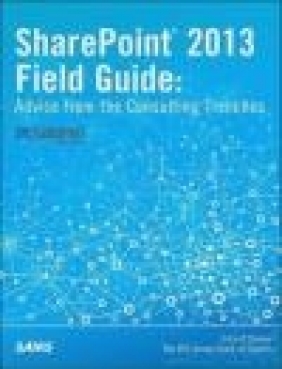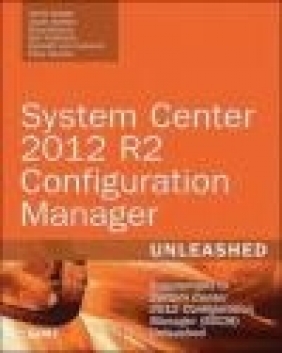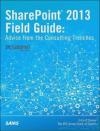SharePoint 2013 Field Guide
Errin O'Connor
SharePoint 2013 Field Guide
Errin O'Connor
- Producent: Sams Publishing
- Rok produkcji: 2014
- ISBN: 9780789751195
- Ilość stron: 816
- Oprawa: Miękka
Niedostępna
Opis: SharePoint 2013 Field Guide - Errin O'Connor
Covers SharePoint 2013, Office 365's SharePoint Online, and Other Office 365 Components In SharePoint 2013 Field Guide, top consultant Errin O'Connor and the team from EPC Group bring together best practices and proven strategies drawn from hundreds of successful SharePoint and Office 365 engagements. Reflecting this unsurpassed experience, they guide you through deployments of every type, including the latest considerations around private, public, and hybrid cloud implementations, from ECM to business intelligence (BI), as well as custom development and identity management. O'Connor reveals how world-class consultants approach, plan, implement, and deploy SharePoint 2013 and Office 365's SharePoint Online to maximize both short- and long-term value. He covers every phase and element of the process, including initial "whiteboarding"; consideration around the existing infrastructure; IT roadmaps and the information architecture (IA); and planning for security and compliance in the new IT landscape of the hybrid cloud. SharePoint 2013 Field Guide will be invaluable for implementation team members ranging from solution architects to support professionals, CIOs to end-users. It's like having a team of senior-level SharePoint and Office 365 hybrid architectureconsultants by your side, helping you optimize your success from start to finish! Detailed Information on How to...* Develop a 24-36 month roadmap reflecting initial requirements, longterm strategies, and key unknowns for organizations from 100 users to 100,000 users * Establish governance that reduces risk and increases value, covering the system as well as information architecture components, security, compliance, OneDrive, SharePoint 2013, Office 365, SharePoint Online, Microsoft Azure, Amazon Web Services, and identity management * Address unique considerations of large, global, and/or multilingual enterprises * Plan for the hybrid cloud (private, public, hybrid, SaaS, PaaS, IaaS) * Integrate SharePoint with external data sources: from Oracle and SQL Server to HR, ERP, or document management for business intelligence initiatives * Optimize performance across multiple data centers or locations including US and EU compliance and regulatory considerations (PHI, PII, HIPAA, Safe Harbor, etc.) * Plan for disaster recovery, business continuity, data replication, and archiving * Enforce security via identity management and authentication * Safely support mobile devices and apps, including BYOD * Implement true records management (ECM/RM) to support legal/compliance requirements * Efficiently build custom applications, workflows, apps and web parts * Leverage Microsoft Azure or Amazon Web Services (AWS)1 Introduction to SharePoint 2013 (On-Premises, Office 365 Cloud, and Hybrid) 1 Key SharePoint 2013 Methodologies and Best Practices 3 Presenting SharePoint 2013 9 Overview of SharePoint 2013 Key Features 10 SharePoint 2013's On-Premises and Office 365 10 SharePoint Server 2013 Technology Updates 12 Feature Comparison of SharePoint On-Premises Versus Office 365/ SharePoint Online 16 SharePoint Server 2013's Capabilities 18 Summary 30 2 Proven Implementation Strategies for SharePoint 2013 and Office 365 | SharePoint Online 31 Where to Begin 31 SharePoint Public Relations and Communications Strategy 36 High-Level Overview of a SharePoint 2013/Office 365 Deployment 40 Identifying the Core Tasks and Milestones of Your Initiative 44 Identifying Common Terms and Features of SharePoint 2013 54 Getting Acquainted with SharePoint Server 2013/Office 365's Architecture and Understanding Its Components 60 Summary 65 3 Governed Utilization of the Features and Functionality in SharePoint 2013/Office 365 67 Understanding Device Channels in SharePoint 2013 (BYOD) 70 SharePoint 2013/Office 365: Preparing for Governance 71 Implementing a Best Practices Information Architecture from the Very Beginning 79 Introduction to SharePoint 2013 and the Hybrid Cloud Mind-Set 82 Social Computing in SharePoint 2013 87 Summary 99 4 Understanding SharePoint 2013 and Microsoft Office Integration with Office 365 Now in the Picture 101 SharePoint 2013 and Office 365: An Overview 102 Planning for Apps in SharePoint and Office 2013 109 Office 365 Compliance 111 How Safe Is My Organization's Office 365 Data? 113 Summary 117 5 Implementing a Best Practices SharePoint 2013/Office 365 Information Architecture 119 Planning SharePoint 2013's Taxonomy, Navigational Hierarchy, and Overall Topology 121 Where to Begin 126 Translating Your Business and Functional Requirements into SharePoint 2013/Office 365 Lists and Libraries 138 Modifying Lists and Libraries 150 Creating and Modifying List and Library Views 160 Working with List Content 163 Creating Discussions and Surveys 166 Summary 170 6 Using Out-of-the-Box Web Parts in SharePoint 2013/Office 365 171 Blog Web Parts 171 Business Data Web Parts 173 Community Web Parts 177 Content Rollup Web Parts 180 Document Sets Web Parts 191 Filters Web Parts 191 Forms Web Parts 192 Media and Content Web Parts 192 Search Web Parts 194 Search-Driven Content Web Parts 195 Social Collaboration Web Parts 195 Summary 196 7 Implementing a SharePoint 2013 System Architecture with Future Hybrid Scalability in Mind 197 Understanding On-Premises, Cloud, and Hybrid Environments in SharePoint 2013 197 Three Major Types of Cloud Services 207 Should I Prepare for a Hybrid SharePoint Platform? 216 SharePoint 2013's System Architecture 218 Key Areas to Consider Regarding Scalability in Your SharePoint 2013 Architectural Roadmap 227 Understanding SharePoint Server 2013 Search Architecture 229 SharePoint 2013 BYOD Best Practices 233 Summary 234 8 Business Intelligence Overview for SharePoint 2013 and Office 365 235 Business Intelligence Considerations in SharePoint 2013 237 Microsoft Excel Services, PowerPivot, and PowerView 240 Microsoft PerformancePoint Overview in SharePoint 2013 243 Visio Services Overview in SharePoint 2013 244 Database Connections and External Data Sources 245 SOAP Service Connection Review 254 REST Service Connection Review 256 Reviewing an XML File Connection 257 Reviewing Linked Data Sources 259 Microsoft's Power BI for Office 365 266 Summary 267 9 Governance Strategies for SharePoint 2013, Office 365, and SharePoint Online 269 Governance Best Practices "from the Trenches" for SharePoint 2013 and Office 365's SharePoint Online 269 SharePoint Architecture Governance 285 Security Governance for SharePoint 2013 and Office 365's SharePoint Online 292 Social Computing Governance 302 Operational and Technical Policies and Standards 304 Uptime and Performance Standards 307 Public and Hybrid Cloud Governance 311 Customization Governance 313 User Interface Governance and Related Policies 317 Acceptable Usage Policy to Enforce in Your Governance Strategy 319 Summary 322 10 Enterprise Content Management (ECM), Records Management (RM), and eDiscovery Best Practices 323 Proven ECM and RM Strategies for SharePoint 2013 and/or SharePoint Online 324 Records Management Best Practices 328 Key RM and ECM Features for SharePoint Server 2013 and SharePoint Online 333 Content Types in SharePoint Server 2013 340 Content Type Hub 341 Content Organizer 341 Library and List Settings in SharePoint 2013 345 Record Center Overview 353 eDiscovery Strategies in SharePoint Server 2013 355 Summary 360 11 Upgrade and Migration Best Practices 361 Ensuring That Your System and Information Architecture Strategy Aligns with Your SharePoint Roadmap 363 Understanding and Reviewing Your Current Technology Landscape 367 Performing a Content and Configuration Assessment on Your Existing Environments 371 SharePoint 2013 Upgrade and Migration Strategy Overview 380 Upgrading or Migrating SharePoint 2007 to SharePoint 2013 381 Upgrading or Migrating SharePoint 2010 to SharePoint 2013 386 Windows PowerShell Related SharePoint 2013 Upgrade and Migration Tasks 391 Summary 406 12 Installation and Configuration 407 Detailing the Installation, Deployment, and Configuration Requirements 408 Implementation Plan Overview-"In the Trenches" Scenario 410 A Proven Installation Process to Follow 414 Overview of the Configuration Process and Related Granular Tasks 416 Summary 428 13 Development Strategies and Custom Applications in SharePoint 2013, Office 365, and SharePoint Online 429 Overview of SharePoint 2013, Office 365, and Microsoft Azure Development Strategies 429 Reviewing the SharePoint App Model and the Composition of an App for SharePoint 440 SharePoint 2013's APIs, Office 365 API Tools, and the Development Options for Accessing Data and Resources 449 Security and Identity Management Considerations for Application Development 458 Development Tools and Related Strategies for Public, Private, and Hybrid Environments 462 Developing Workflows in SharePoint 2013, Office 365, and SharePoint Online 481 BCS, External, and LOB Systems Integration Strategies 496 Summary 489 14 Search, Web Content Management, Branding, and Navigational Strategies 501 Overview of Search in SharePoint 2013, Office 365, and SharePoint Online 502 Web Content Management Feature Deep-Dive 524 Multilingual Sites in SharePoint 2013, Office 365, and SharePoint Online 538 Implementing Custom Branding for SharePoint 2013, Office 365, and SharePoint Online 543 Summary 551 15 Administration and Maintenance Strategies 553 SharePoint 2013, Office 365, and SharePoint Online Administration Overview 553 SharePoint 2013 Administration Considerations 559 SharePoint Admin Center in Office 365 566 Exchange Admin Center in Office 365 569 Lync Admin Center in Office 365 573 SQL Server 2012/2014 Best Practice Administration for SharePoint 2013 575 SharePoint 2013 Backup and Recovery 577 Windows PowerShell Administration Overview 579 System Center 2012 Overview 581 Administration of Mobile Devices 582 Summary 583 16 Social Networking and My Site Strategies 585 Overview of Social Capabilities in SharePoint 2013, Office 365, and SharePoint Online 585 SharePoint Communities: Best Practices and Proven Strategies 586 My Sites in SharePoint 2013, Office 365, and SharePoint Online 595 Yammer Overview 602 Summary 603 17 SharePoint 2013, Office 365, and SharePoint Online: Training and End-User Adoption Strategies 605 Key Considerations and Strategies to Ensure Long-Term Training Success 606 Training Requirements and Required Knowledge of Your Users 610 Using Training to Drive User Adoption 616 Implementing a SharePoint and/or Office 365 Training Site for Your Organization 619 Free Training Material and Courses Available from Microsoft 620 Summary 622 18 Disaster Recovery (DR) and Business Continuity Management (BCM) Considerations 623 Developing a Best Practices Approach to Disaster Recovery and Business Continuity for SharePoint 2013 623 Preparation for SharePoint 2013 DR/BCM 624 Inventory of SharePoint 2013 and Related Components 628 Backup of SharePoint 2013 and Related Content and Components 631 Restoration of the Environment 642 Summary 648 Index 649
Szczegóły: SharePoint 2013 Field Guide - Errin O'Connor
Tytuł: SharePoint 2013 Field Guide
Autor: Errin O'Connor
Producent: Sams Publishing
ISBN: 9780789751195
Rok produkcji: 2014
Ilość stron: 816
Oprawa: Miękka
Waga: 1.07 kg






















